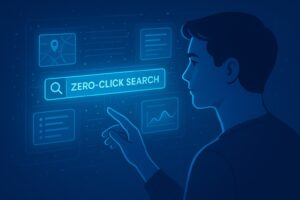Have you ever checked your website analytics and seen odd patterns? For example, sudden spikes in visits, high bounce rates, or traffic from strange places? Chances are, you’ve encountered something called bot traffic. Knowing how traffic bots work is important for your SEO. This is especially true if you want to grow your site naturally.

In this blog, we will explain what a traffic bot is. We will look at terms like best CTR bot, SearchSEO, and SEO traffic bot generator. We will also answer questions like, “Will fake traffic affect website ranking?” all in simple, clear language.
What is a Traffic Bot?
A traffic bot is a software program designed to simulate a human visitor to a website. These bots are programmed to visit pages, click on links, or generate impressions, all without a real human involved.
Some bots are harmless (and even helpful), but others can cause serious issues for website owners and marketers.
If you’re asking, “What is traffic bot?”, you’re likely dealing with discussions around fake traffic used to manipulate SEO or ad performance.
How Do Traffic Bots Work?
Traffic bots mimic user behaviour online. They can be programmed to:

- Visit a specific webpage
- Stay on a page for a certain amount of time
- Click on links or advertisements
- Bounce from page to page to simulate browsing behaviour
Some more advanced bots even simulate mouse movements or scrolling to make the visit seem more human-like.
There are even tools available online, sometimes labelled “SEO traffic bot generators” or “CTR bot tools” – that claim to increase your website traffic by sending thousands of automated visits.
But here’s the big question: Are these bots good or bad for SEO?
Good Bots vs Bad Bots

Good Bots:
Good bots help improve your website. Examples include:
- Googlebot: Crawls your website, so it appears in search results.
- Bingbot: Works similarly to Microsoft’s search engine.
- SEO audit tools like Ahrefs, SEMrush, and Screaming Frog.
These bots collect data, help search engines understand your content and improve your online visibility.
Bad Bots:
Bad bots pretend to be real visitors, but they don’t actually engage with your content. They can:
- Generate fake traffic that skews your analytics
- Simulate clicks on search results (CTR manipulation)
- Perform click fraud by clicking on paid ads repeatedly
- Scrape content or try to steal information
These bots are often used to trick algorithms, either for SEO gains or advertising revenue.
Why People Use Bots to Increase Website Traffic?

Some website owners tempt themselves to use bots to create the illusion of high traffic or engagement. There are services and tools online that market themselves as:
- SEO traffic bot generator
- Free traffic bot software
The promise is that by increasing your site’s click-through rate (CTR) or visits, you’ll rise in the search rankings.
Their promises might include:

- Higher rankings on Google
- More impressions
- Better ad revenue
- Attracting more real users by appearing “popular”
But there’s a big problem: Google and other search engines are smarter than you think.
Will Fake Traffic Affect Website Ranking?
Yes, but not in a positive way. Fake traffic typically leaves the website quickly without interacting, which signals poor user engagement. Time spent on a page is a key metric in identifying such traffic. It often comes from link farms, traffic exchanges, or bots.
Low engagement can sharply increase the bounce rate, which may trigger Google’s spam detection systems. If Google suspects manipulation, it may impose a manual action penalty. You can check this in the Manual Actions section of Google Search Console. Such penalties can result in a significant drop in rankings or even cause your site to be removed from search results altogether.

1. Skewed Analytics
Your reports will show high visits, but:
- Very short session durations (0- 3 seconds)
- Extremely high bounce rates
- No conversions or engagement
This makes it harder to make real marketing decisions.
2. Algorithm Detection
Google uses AI and behaviour signals to evaluate traffic quality. Repeated bot behaviour (like rapid CTR spikes or sudden engagement drops) can trigger red flags. They may penalise you or de-rank you.
3. Wasted Ad Spend
If bots click on your paid ads, it could drain your marketing budget. People refer to this as click fraud, and it poses a serious issue in digital advertising.
4. Loss of Trust
Using SEO traffic bot generators can damage your brand and reputation. If partners, clients, or advertisers find out, it could lead to negative consequences.
Real-World Example: How Fake Traffic Looks
Imagine you run a blog and suddenly see 5,000 visits in one day – all from a single location (say, Ukraine or Brazil), all with 100% bounce rate and 0 seconds average session time.
This is almost certainly bot traffic.
It might look impressive on the surface, but it’s not real growth. You won’t see real readers engaging with your content, subscribing to your list, or buying your product.
How to Detect Traffic Bots in Google Analytics (GA4)?
You can usually spot traffic bots using these signals:
| Indicator | What It Means |
|---|---|
| High bounce rate (90–100%) | Users leave instantly (probably bots) |
| Very low session duration | No time spent reading |
| Spikes from unknown sources | Bots often come from unknown referrers |
| Traffic from odd countries | Check if it matches your target audience |
| Repeating IP addresses | Automated scripts usually come from the same source |
Tools to Help:
The Risks of Using CTR Bots for SEO
Some tools promote themselves as “best CTR bots” and promise to increase your rankings by faking clicks on your listings in Google search results.
While CTR is a ranking factor, Google tracks more than just the click:
- How long the user stays
- If they bounce right away
- Whether they engage with your site
If fake users don’t engage, your metrics actually send negative signals. Over time, you may drop in rankings instead of climbing.
Better Alternatives to Fake Traffic Bots
Instead of using bots to increase website traffic, focus on these organic SEO strategies:
1. Create High-Quality Content
Write helpful, original blog posts that answer user questions. Use tools like AnswerThePublic and SEMrush to find popular topics.
2. Optimise for Real Users
Use keywords naturally, write clean meta descriptions, and make sure your site loads fast and works well on mobile.
3. Get Backlinks from Real Sites
Instead of paying for fake traffic, earn links from other trusted websites through:
- Guest posting
- Partner collaborations
- Creating valuable resources or data
4. Promote on Social Media & Email
Share your content on platforms where your real audience spends time. Build a subscriber list and keep them engaged.
Key Takeaways for SEOs
- Traffic bots are automated tools that simulate web visits.
- Using a CTR bot or SEO traffic bot generator might give a short boost, but it risks long-term penalties.
- Google is constantly improving its ability to detect fake engagement.
- Real SEO success comes from genuine traffic, great content, and user engagement.
Final Words
If you’re serious about SEO, don’t fall for shortcuts. Tools advertised as “best CTR bot” or “traffic bot generators” may seem appealing, but they often backfire. Focus on attracting real people, not fake clicks.
Yes, growing traffic is hard work, but with the right strategies, it’s 100% possible without bots. Keep it clean, play the long game, and watch your rankings grow naturally.





